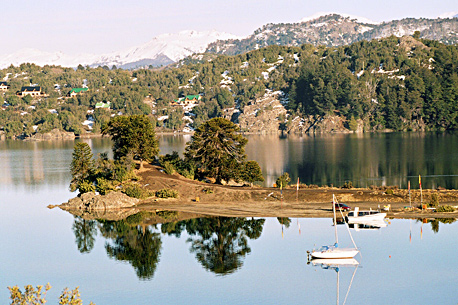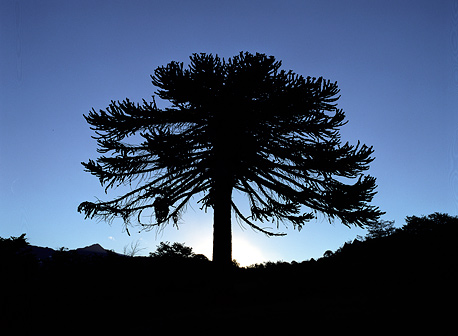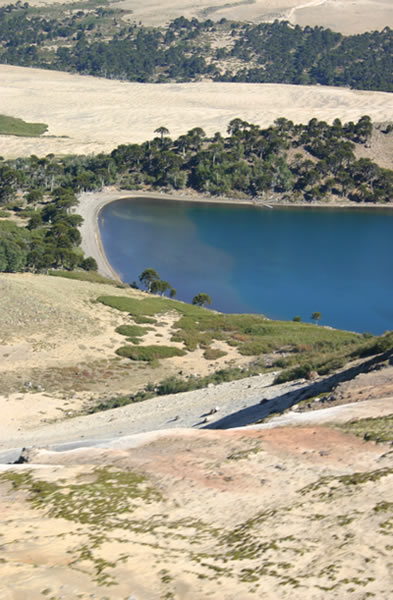Small but very cozy, Villa Pehuenia Moquehue is located on the north bank of Lake Aluminé, close to its union with Lake Moquehue. A postcard environment surrounds it: lakes, mountains, forests and small beaches of volcanic sand.

The Aluminé beach is low here, very different from the opposite margin that has cliffs. There are countless capes and bays, islands with Pehuenes (a local tree), crystal clear and warm waters.
The village is on the coast of the lake has no specific planning, there are summer houses, picnic areas, some inns and camping areas. It was founded in 1989 and when the time to give it a name came, there were no doubts: it only took one look around when the sacred and imposing tree of the Mapuches stood out.
The Pehuén
The name of the village comes from the beautiful Araucaria, a typical tree from the area that is nowadays cultivated all over the world. Pehuén or “araucaria araucana” is it’s original name in indigenous language.

There are other species related to it that can be found in Australia. The fact that it can only be found in such distant places evidences its ancient origin which dates back from the times in which the continents were one.
This tree is considered to be sacred for the aborigines that inhabited this region, first the Pehuenches and then the Mapuches. Its fruits, the “piñones” where the main ingredient of their diet. The piñones have high levels of carbon hydrates. Nowadays it is forbidden to collect large numbers of said fruits; only the Mapuche communities that inhabit that area are allowed to collect them.
What to see and do in Villa Pehuenia Moquehue
The village is a base for camping and it has several inns. There are many beaches, fishing spots and places where you can practice water sports and there is also the possibility of going for a stroll and to go horseback riding.
Its main attraction is in the mountain range area, surrounded by the Aluminé and Moquehue lakes and with the profile of mountains covered with pines in the horizon.
Hiking: The villa is surrounded by natural viewpoints easily accessed on foot. Some of these trails traverse territories of the Mapuche Puel community, which in adition to the contact with nature allows a cultural journey meeting with representatives of that people.

Rafting: Pehuenia Moquehue is an internationally recognized place for the practice of this sport in the waters of the Aluminé river . October and December, the most abundant water months, are ideal for those who like to experience more adrenaline . However, departures are made throughout the rest of the summer season and there are options for both, experts and beginners. Several tour operators offer these outings.
Fishing: Very diverse environments such as lakes, streams, ponds and rivers offer the possibility to practice this sport. They are also varied species: perch is native, but there are several species of introduced trout: brown, rainbow and brook. The fishing season runs from November to May. Take advice on site about allowed modalities and necessary license.
Horse Riding: There are several trails that can be explored on horseback. One of the most recommended is the climb to the top of the Batea Mahuida volcano, an exceptional panoramic viewpoint from where you have a full view of the lakes Aluminé and Moquehue.
Waters sports: The calm waters of the lake allow navigation in rowboats and motorboats. The number of islands, islets and peninsulas of its jagged coastline make it an ideal environment to discover beaches and hidden corners.
How to get there
You can get to this place from Zapala and also from the northern part of Neuquén, in the middle of a landscape that cannot be often found, and from Chile through the Pino Hachado passage.
The most important route from the tourism point of view is the cone that comes from the south and that connects this area with the rest of the lakes of the northern part of Patagonia.
It is 122km from Zapala. You will go through the Parque de Nieve Primeros Pinos. One part is paved and the other one is in good conditions in spite of not being paved. There are winding parts of the route before and after the Puente del Cochicó. You will be able to see the beautiful hills of Catan Li that are covered in Pehuenes. The road borders the Litrán river, where many fishermen camp or spend the day. After crossing this river you will start bordering the Aluminé Lake until reaching the Village.
It is 60km from Pino Hachado, an unpaved road that is not always in good conditions. Near the passage there are many watercourses and later there are sandy parts. This area is mainly used for the “veranadas” (seasonal migrations of the states, specially goats and sheep), for said reason you will be able to see the precarious houses that the shepherds use during winter and summer.
This is the same route that can be taken from the northern part of Neuquén.
Where to stay
Within the village there are inns, cottages for rent and camping areas, whether organized camping or in the wild. There are also many residential and tourism houses of the area that can be rented for fifteen days or by month during high season.























